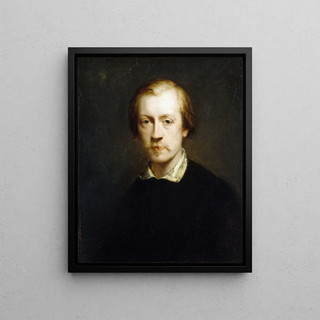Art print | Portrait of the painter Félix Ziem - Gustave Ricard


View from behind

Frame (optional)
In the world of art, certain works transcend their era to become timeless witnesses of human emotions and artistic aspirations. The "Portrait of the painter Félix Ziem" by Gustave Ricard is one of these remarkable pieces. This painting, which captures not only the physical resemblance of its subject but also his essence, immerses us in a universe where painting becomes a reflection of personality. Through this portrait, Ricard does not merely depict Ziem; he invites us to explore the soul of a passionate artist, while offering a window into the creative world of the 19th century.
Style and uniqueness of the work
Gustave Ricard's style is distinguished by an undeniable mastery of colors and lights. In this portrait, each brushstroke seems charged with a precise intention, revealing a refined technique that combines realism and impressionism. The warm tones and delicate shadows help create an intimate atmosphere, where the viewer is invited to approach Ziem's figure. The composition, balanced and harmonious, highlights not only the painter's face but also the details of his environment, which tell a story in itself. The elements surrounding him, carefully chosen, add a narrative depth to the work, emphasizing the richness of the artistic universe in which Ziem evolved. Thus, the art print Portrait of the painter Félix Ziem - Gustave Ricard becomes a true immersion into the life of a man whose life was dedicated to art.
The artist and his influence
Gustave Ricard, born in 1823, was a French painter whose work was deeply influenced by the artistic currents of his time. A student of great masters, he developed a personal style that allowed him to stand out within the artistic scene. His friendship with Félix Ziem, a painter famous for his maritime landscapes and scenes of Venice, played a crucial role in his career. By choosing to paint the portrait of Ziem, Ricard not only pays homage to a friend but also places his work within an artistic tradition where camaraderie and mutual respect among artists are essential. This

Matte finish

View from behind

Frame (optional)
In the world of art, certain works transcend their era to become timeless witnesses of human emotions and artistic aspirations. The "Portrait of the painter Félix Ziem" by Gustave Ricard is one of these remarkable pieces. This painting, which captures not only the physical resemblance of its subject but also his essence, immerses us in a universe where painting becomes a reflection of personality. Through this portrait, Ricard does not merely depict Ziem; he invites us to explore the soul of a passionate artist, while offering a window into the creative world of the 19th century.
Style and uniqueness of the work
Gustave Ricard's style is distinguished by an undeniable mastery of colors and lights. In this portrait, each brushstroke seems charged with a precise intention, revealing a refined technique that combines realism and impressionism. The warm tones and delicate shadows help create an intimate atmosphere, where the viewer is invited to approach Ziem's figure. The composition, balanced and harmonious, highlights not only the painter's face but also the details of his environment, which tell a story in itself. The elements surrounding him, carefully chosen, add a narrative depth to the work, emphasizing the richness of the artistic universe in which Ziem evolved. Thus, the art print Portrait of the painter Félix Ziem - Gustave Ricard becomes a true immersion into the life of a man whose life was dedicated to art.
The artist and his influence
Gustave Ricard, born in 1823, was a French painter whose work was deeply influenced by the artistic currents of his time. A student of great masters, he developed a personal style that allowed him to stand out within the artistic scene. His friendship with Félix Ziem, a painter famous for his maritime landscapes and scenes of Venice, played a crucial role in his career. By choosing to paint the portrait of Ziem, Ricard not only pays homage to a friend but also places his work within an artistic tradition where camaraderie and mutual respect among artists are essential. This






